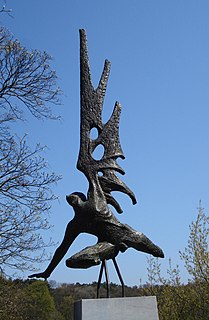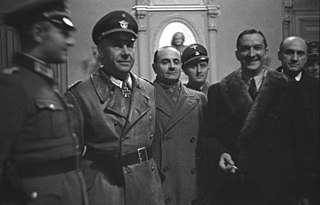 W
WThe Reich Security Main Office was an organization subordinate to Heinrich Himmler in his dual capacity as Chef der Deutschen Polizei and Reichsführer-SS, the head of the Nazi Party's Schutzstaffel (SS). The organization's stated duty was to fight all "enemies of the Reich" inside and outside the borders of Nazi Germany.
 W
WAmersfoort concentration camp was a Nazi concentration camp near the city of Amersfoort, the Netherlands. The official name was "Polizeiliches Durchgangslager Amersfoort", P.D.A. or Amersfoort Police Transit Camp. 37,000 prisoners were held there between 1941 to 1945. The camp was situated in the northern part of the municipality of Leusden, on the municipal boundary between Leusden and Amersfoort in the central Netherlands.
 W
WThe Blechhammer area was the location of Nazi Germany chemical plants, prisoner of war (POW) camps, and forced labor camps. Labor camp prisoners began arriving as early as June 17, 1942, and in July 1944, 400–500 men were transferred from the Terezin family camp to Blechhammer. The mobile "pocket furnace" crematorium was at Sławięcice.) and Bau und Arbeits Battalion 21 was a mile from the Blechhammer oil plants and was not far from Kattowitz and Breslau. Blechhammer synthetic oil production began April 1, 1944 with 4000 prisoners, with the slave labor camp holding these prisoners during April 1944, becoming a satellite camp of the dreaded Auschwitz extermination camp, as Arbeitslager Blechhammer.
 W
WThe Carlingue were French auxiliaries who worked for the Gestapo, Sicherheitsdienst and Geheime Feldpolizei during the occupation of France in the Second World War.
 W
WCentral Office for Jewish Emigration was a designation of Nazi institutions in Vienna, Prague and Amsterdam. Their head office, the Reich Central Office for Jewish Emigration, was based in Berlin. Their purpose was to expel Jews from Nazi-controlled areas.
 W
WEinsatzgruppen were Schutzstaffel (SS) paramilitary death squads of Nazi Germany that were responsible for mass killings, primarily by shooting, during World War II (1939–1945) in German-occupied Europe. The Einsatzgruppen had an integral role in the implementation of the so-called "Final Solution to the Jewish Question" in territories conquered by Nazi Germany, and were involved in the murder of much of the intelligentsia and cultural elite of Poland, including members of the Catholic priesthood. Almost all of the people they killed were civilians, beginning with the intelligentsia and swiftly progressing to Soviet political commissars, Jews, and Romani people, as well as actual or alleged partisans throughout Eastern Europe.
 W
WEnglandspiel, or Operation North Pole, was a successful counterintelligence operation of the Abwehr from 1942 to 1944 during World War II. German forces captured Allied resistance agents operating in the Netherlands and used the agents' codes to dupe the United Kingdom's clandestine organization, the Special Operations Executive (SOE), into continuing to infiltrate agents, weapons, and supplies into the Netherlands. The Germans captured nearly all the agents and weapons sent by the United Kingdom (Britain).
 W
WGiulio Cesare Andrea Evola, better known as Julius Evola, was an Italian philosopher, poet, and painter whose esoteric worldview featured antisemitic conspiracy theories and the occult. He has been described as a "fascist intellectual", a "radical traditionalist", "antiegalitarian, antiliberal, antidemocratic, and antipopular", and as "the leading philosopher of Europe's neofascist movement".
 W
WThe Geheime Staatspolizei, abbreviated Gestapo, was the official secret police of Nazi Germany and in German-occupied Europe.
 W
WGross-Rosen was a network of Nazi concentration camps built and operated by Nazi Germany during World War II. The main camp was located in the German village of Gross-Rosen, now the modern-day Rogoźnica in Lower Silesian Voivodeship, Poland; directly on the rail-line between the towns of Jawor (Jauer) and Strzegom (Striegau). Its prisoners were mostly Jews, Poles and Soviet citizens.
 W
WPolish decrees, Polish directives or decrees on Poles were the decrees of the Nazi Germany government announced on 8 March 1940 during World War II to regulate the working and living conditions of the Polish workers (Zivilarbeiter) used during World War II as forced laborers in Germany. The regulation intentionally supported and even created anti-Polish racism and discrimination on the grounds of ethnicity and racial background.
 W
WThe Prinz-Albrecht-Palais was a Rococo city palace in the historic Friedrichstadt suburb of Berlin, Germany. It was located on Wilhelmstrasse 102 in the present-day Kreuzberg district, in the vicinity of Potsdamer Platz.
 W
WReich Security Head Office Referat IV B4, known as RSHA IV B4, was a sub-department of Germany's Reich Security Head Office and the Gestapo during the Holocaust. Led by SS-Obersturmbannführer Adolf Eichmann, RSHA IV B4 was responsible for "Jewish affairs and evacuation" in German-occupied Europe, and specifically for the deportation of Jews from outside Poland to concentration or extermination camps. Within Poland, the liquidation of the ghettos and transport of Jews was handled by the SS and local police departments.
 W
WSalaspils camp was established at the end of 1941 at a point 18 km (11 mi) southeast of Riga (Latvia), in Salaspils. The Nazi bureaucracy drew distinctions between different types of camps. Officially, it was the Salaspils Police Prison and Re-Education Through Labor Camp. It was also known as camp Kurtenhof after the German name for the city of Salaspils. Planning for the development of the camp and its prisoner structure changed several times. In 1943, Heinrich Himmler briefly considered converting the camp into an official concentration camp (Konzentrationslager), which would have formally subordinated the camp to the National Security Main Office, but nothing came of this. The camp has had a lasting legacy in Latvian and Russian culture due to the severity of the treatment at the camp, especially with regard to children.
 W
WSalon Kitty was a high-class Berlin brothel used by the Nazi intelligence service, the Sicherheitsdienst (SD), for espionage purposes during World War II.
 W
WThe Sicherheitspolizei, often abbreviated as SiPo, was a term used in Germany for security police. In the Nazi era, it was used to describe the state political and criminal investigation security agencies. It was made up by the combined forces of the Gestapo and the Kriminalpolizei between 1936 and 1939. As a formal agency, the SiPo was incorporated into the Reich Security Main Office (RSHA) in 1939, but the term continued to be used informally until the end of World War II in Europe.
 W
WSpecial Prosecution Book-Poland was the proscription list prepared by the Germans immediately before the onset of war, that identified more than 61,000 members of Polish elites: activists, intelligentsia, scholars, actors, former officers, and prominent others, who were to be interned or shot on the spot upon their identification following the invasion.
 W
WZollgrenzschutz (ZGS) was an organization under the German Finance Ministry from 1937 to 1945. It was charged with guarding Germany's borders, acting as a combination Border Patrol and Customs & Immigration service.